All you need to know about the Domus Aurea, Emperor Nero’s lavish palace. How to visit the Domus Aurea, best tours, fun and interesting facts and tips for visitors
The Domus Aurea is the lavish construction Emperor Nero created in Rome as his imperial palace.
Built in the I century AD by the design of Nero himself, it is one of the most interesting archaeological sites in Rome and a fantastic historical site in Rome that can be enjoyed by adults and children alike.
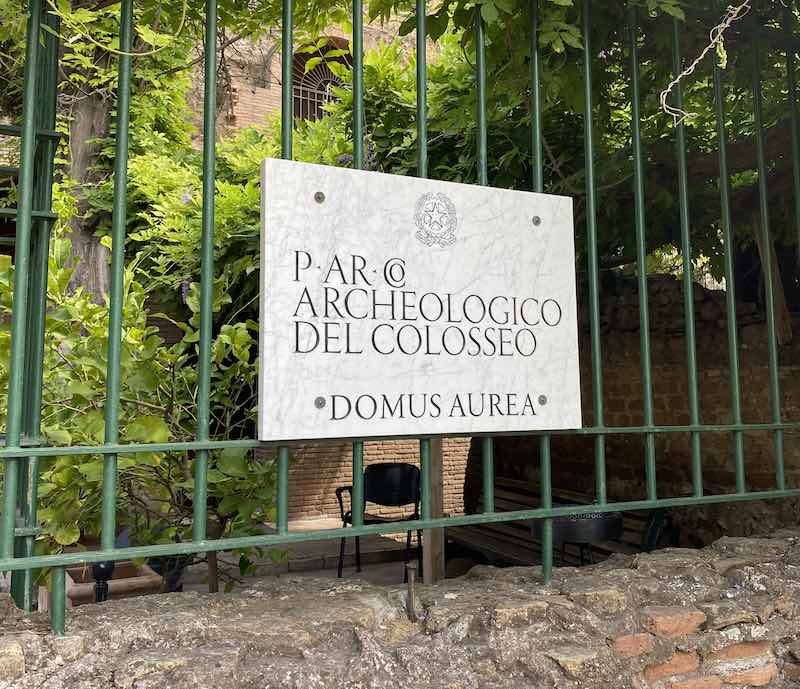
Hidden underground for centuries and still nowadays lying below street level, the Domus Aurea is a peculiar and challenging building for archaeologists and a treat for history lovers.
Impressive excavation work has brought part of the of the Domus back to light and several sections of it are now open to the public.
However, due to the fragility of the environment and the peculiarity of it being underground, it is helpful to have some practical info before going for your visit.
In this article, I will discuss how to get tickets for the Domus Aurea, what to expect, what to carry with you, tips for visiting the Domus Aurea with kids, and some info about the Domus Aurea that will help you put into context enjoy it at best.
The Domus Aurea is one of the most exciting underground attractions in Rome and one I strongly recommend you add to your Rome itinerary.
Please note: this post contains affiliate links and, should you make a purchase through them, we might make a small commission.
What is the Domus Aurea?
The Domus Aurea is the over-the-top imperial palace build by emperor Nero (I century AD).
Built in only 4 years, between 64 and 68 AD, the Domus Aurea was colossal and followed a grand design by the Emperor himself.
According to ancient sources and archaeological findings, it extended over three of the seven hills of Rome and occupied over 50 hectares (over 123 acres).
It comprised rooms, patios, gardens and was also lavishly decorated.
Lover of the arts and entertainment, Nero wanted his house to be worthy of a man of his might and stature and a space that would satisfy his every need.
The Domus Aurea was the biggest home ever built in Rome at the time and, for size, luxury and use, has been described as ‘a Versailles in the heart of Rome’ (A. Carandini, roman archaeology professor at the University of Rome).
Ancient sources tell us that Nero supervised every detail of the building and ended up satisfied with it.
According to Suetonius, the first time he entered his completed home he said: ‘Good! Finally, I can start living like a human being’.
Nero didn’t make history as a modest man!
What does Domus Aurea mean?
Domus Aurea means ‘golden house’ (in Latin: Domus= home; Aurea=golden) and ancient writers tell us the house indeed shone like gold, with natural light reflecting itself on precious marbles, water games and rare metals.
It also seems to have had a golden dome, which was probably the main reason behind its name.
The Domus Aurea in the words of Suetonius
Our main source of information about the decor of the Domus Aurea is historian Suetonius, who described it as follows:
‘There was a vestibule with a colossal statue of him (Nero), 120 feet tall. [The palace] was so big, it had porticoes with three sets of columns, one thousand steps long, and a pond that looked like the sea, surrounded by buildings that looked like cities.
Inside (the Domus Aurea), there were fields, vineyards, pastures and forests, with domesticated and wild animals of all sorts. In all parts of the building, everything was golden and decorated with gems and mother of pearl.
The ceilings of the entertainment halls had perforated, moving ivory tiles that diffused petals and perfumes. The main one of these salons was round and turned on itself, continuously, like the earth.’
The Domus Aurea now
The Domus Aurea nowadays is a pale remnant of what it used to be.

After Nero’s death, all that had to do with this cruel emperor went through destruction, including his house.
When Emperor Vespasian took power, we wanted to symbolically ‘give back’ to the people the space Nero had claimed for himself and destroyed large part of the Domus Aurea’s gardens, which he then used as grounds for building the Colosseum, a space devoted to free games for the pleasure of all Rome inhabitants.
What remained of the house was later filled with soil and turned into the foundations of the Thermal Baths of Trajan, which condemned the Domus to become an underground space, as it still is today.
While the size of the site and the excellent conservation work by archaeologists allow getting a sense of what the Domus must have been like, the palace is now fully underground and retains very little of its original décor.
Visiting the Domus Aurea, you will not see an airy palace that will make you feel like an ancient ruler. Rather, you will walk in huge underground tunnels, with brick walls and remains of ancient frescos and mosaics.
This doesn’t mean the site is not impressive.
You are sure to marvel at the height and might of the palace’s corridors and spaces, even if the light that flooded the place and the views over Rome are now gone!
Is the Domus Aurea worth visiting?
The Domus aura is very impressive and worth visiting for anyone with an interest in Roman history.
The peculiar history of the Domus is an excellent introduction to Imperial Rome in terms of topography and history. The guides are fantastic and bring the place back to life.
The Domus is underground however, the spaces are vast and the ceilings high, so it should not cause issues to people with claustrophobia.
It is a place below ground level and with no windows, so you may want to be aware of this should you or someone in your party find this distressing.
Domus Aurea Tickets: how to book a visit to Domus Aurea
Visits to the Domus Aurea are by guided tours only.
You can find tickets at the following addresses:
Domus Aurea Guided Tour by Parco Colosseo. This is the official ticketing channel and the cheapest way to visit the Domus Aurea, as you get tickets directly from the company that manages the site. The official site is this one
The quality of this guided tour is exceptional: we have taken the tour several times, with and without the kids, and always fond the guides to be outstanding.
Something special! Sometimes you are given the option to add a VR headset experience, to have at the end of the tour. If you see it available, get it, it is so worth it! The headset covers your head entirely and makes you feel inside the Domus as it used to be. this is not just a small visor but a full immersive experience and I highly recommend it. Just Bec careful with your kids as it is really immersive, my daughter had to take it off at times as she felt is was too weird!
Other tours you may want to consider are:
Small-Group Domus Aurea and Colosseum VR Tour by LivTours: the Colosseum is in front of the Domus and the sites are easy to visit in one session.
Where is the Domus Aurea and how to get there
The Domus Aura is in Rome city center and more precisely on the Oppian Hill, the southernmost part of the Esquiline Hill, in front of the Colosseum.
You access the house from the Oppian Hill park. Domus Aura address: Via di Serapide (Colle Oppio)
The closest metro station is ‘Colosseo’ and the nearest buses are Bus: n. 51, 85, 87, Tram: n. . The entrance to the Domus Aurea is less than a 5 minute walk from the stop (it is, however, uphill).
Taxis can drop you at the park entrance from where you can reach the main door with a less than 2 minute walk. Taxis cannot drop you off right at the entrance of the Domus since the park is a car-free zone.
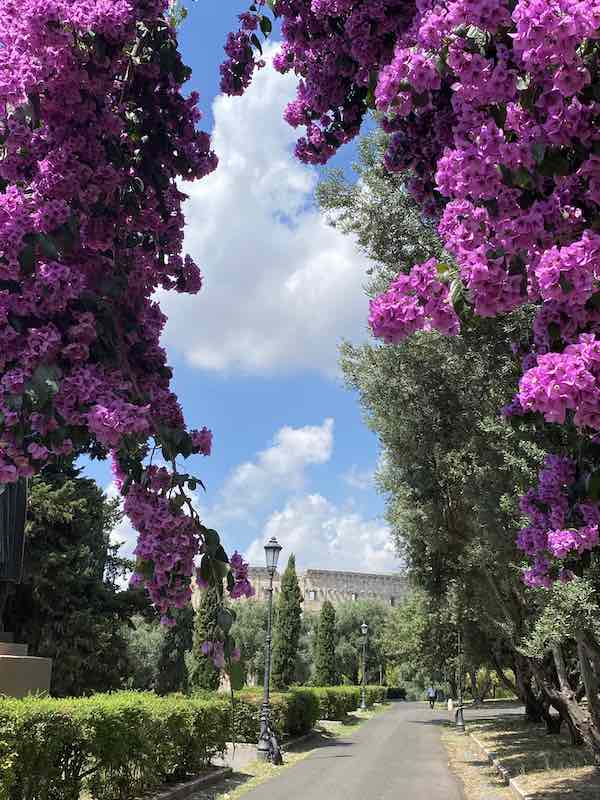
What to expect on a Domus Aurea visit
What a visit to the Domus Aurea entails depends on when you go. The Domus is used for exhibitions so the exact tour will operate around those.
For instance, the first time we went, we saw an exhibition about the ‘grottesche’ which are the specific type of frescos you find in the Domus, while the second time we saw an outstanding exhibition about Nero and Egypt.
In all cases, you see the Domus. Below there is the account of one of our visits.
I believe this experience will help you get ready for your own visit, also if you opt for a different tour provider.
The best things to see in the Domus Aurea – our experience
The introductory video or exhibition area
As I mentioned above, we had slightly different experiences on our different visits. The first one include a video at the start (this is what the account below is about) and the second one include a VR experience at the end.
Upon entering, you meet your guide, who will be waiting for you at the main Domus door.
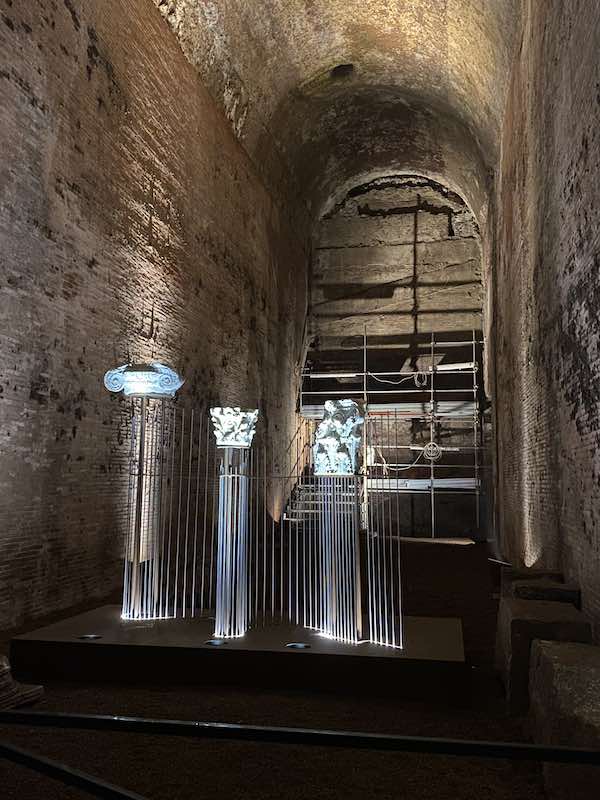
At the start, the guide stops at a plan of the Domus and explains the basics of its structure.
This is a very interesting part of the tour. The Domus was so colossal, once you are inside you don’t really get a sense of its shape.
The map and explanation make it easier to appreciate the enormity and complexity of the space.
After this, you see a video, which is one of the highlights of the tour.
The video only lasts a few minutes and it is projected on one of the walls. It shows with the aid of lights how to Domus would have looked like and it is an incredible sight.
What is left of the Domus is not even a pale impression of the original built.
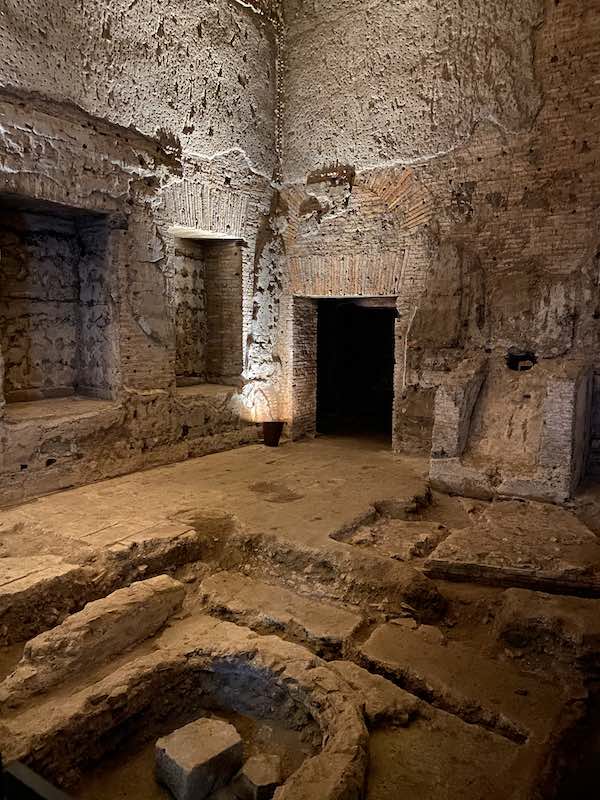
In its heyday, the Domus opened up onto extensive gardens and used to receive a lot of natural light.
It was colorful and highly decorated and it has water games and materials that would make it.
Without the video, it is very hard to visualize what it would have looked like but this, way, it truly comes back to life!
After the video, the tour leads you to several parts of the house. The space is very impressive and the guide is full of anecdotes about it.
Some of these stories come from the time of Nero, but many come from the many centuries after his death.
I am going through some of them below, in the section about fun and interesting facts about the Domus Aurea.
The mighty corridors
Walking around the Domus Aurea feels like walking into a maze of massive corridors.
The corridors are very long, have very high ceiling and they are now almost entirely made of exposed bricks.
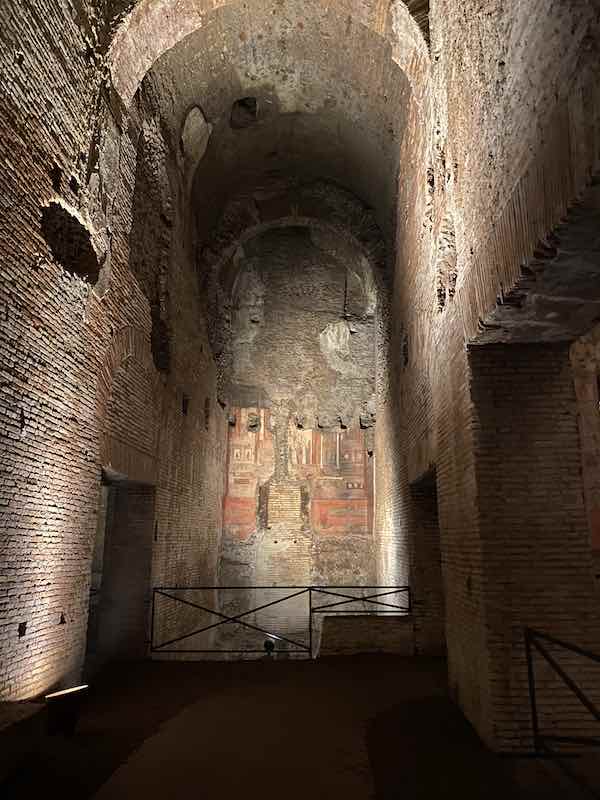
The bricks would have been the support to slabs of precious stone and metal decorations or, in some cases, would have been covered by a layer of plasterboard and frescoes.
Many of the original decorations are gone but many are still visible.
Even when they are not, however, the corridors of the Domus Aurea make an impression. Their size speaks volumes about what this palace must have been like!
The frescoes on the walls and ceiling of the Domus Aurea
The tour devotes attention to many architectural elements of the house and points some of the beautiful frescoes and mosaics remaining and the challenges archaeologists face to preserve and study this house.
Most of the decorations are highly damaged however, good lighting means they are easy to spot (with a guide!) and the overall experience is fulfilling and satisfying.
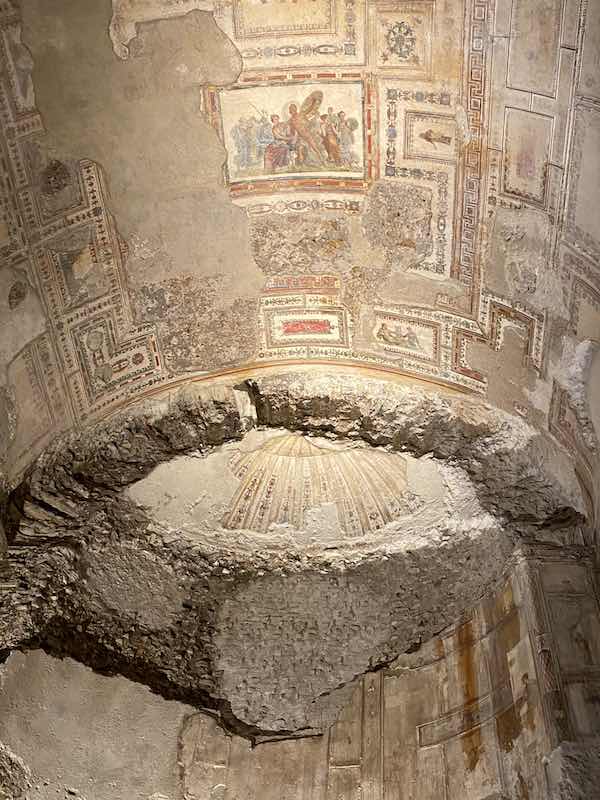
Some worth noticing are the frescoes in Pompeian style, among the best we have from the era, interesting depictions of Anubis, the Egyptian God that was worshipped beside traditional Roman Gods and Goddesses after the conquest of Egypt and the famous Hector and Andromache fresco in the last room.
The mosaic and Ulysses and Polyphemus
The Domus Aurea has several water areas and one of the is famous for a peculiar mosaic depicting Ulysses and Polyphemus.
The mosaic is high on the ceiling (an info panel has a reproduction of it that helps see its details) and it is beautiful and significant as one of the first examples of figurative mosaic work we have.
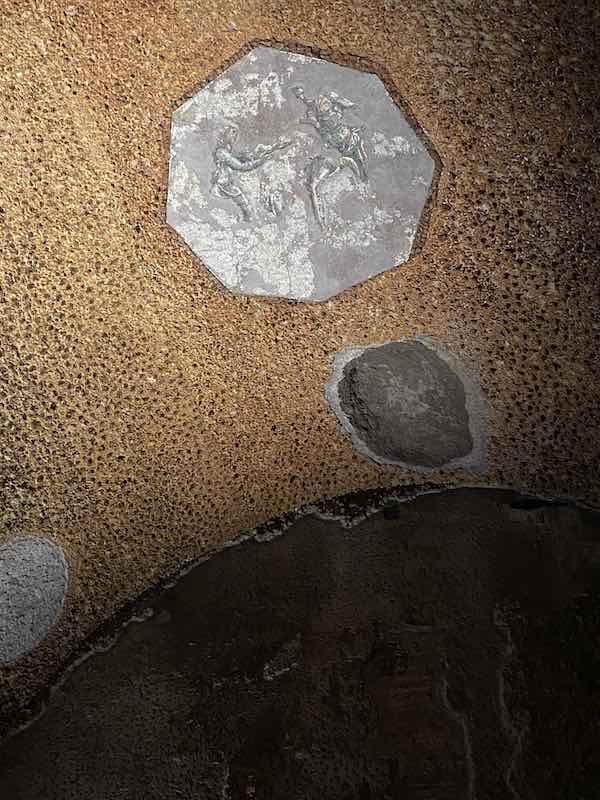
The Domus Aurea convivium room (dining room)
One of the best preserved and most interesting rooms in the Domus Aurea is the dining room.
Unlike others, this room still maintain its mosaic floor and also its original wall paint.
Fun fact! The paint in this room is black. Since there was an open fire always ready for the entertaining needs of the Emperor, the paint color was chosen to disguise the inevitable wall-stains the smoke would create! The effect is till nowadays visually very strong!

The XV century ceiling holes
If you look at the celling of several of the Domus Aurea’s rooms, you will notice large holes.
These ware made in the XIV century by thieves who used to climb down into the Domus with ropes to steal precious materials and treasures!
The holes are incredible to see and the story of their origin one of the many things that make the Domus Aura so unique.
The Octagonal room
The last room in the tour is the octagonal room and it is special.
Ancient historians tell us that the Domus had a rotating dining room and the impression it must have left has been recreated with a light show. It is not to be missed!
Fun and interesting facts about the Domus Aurea history
The Domus Aurea is the palatial residence in Rome built by Emperor Nero.
It was built in only 5 years and was ordered after the destruction of the Domus Transitoria, Nero’s house on the Palatine, during the devastating Rome fire of 64AD.
The house is now a ruin however, Suetonius tells us at length about it and his account allows archaeologists to have a good sense of what the house would have been like.
The Domus was enormous. It used to stretch from the Palatine Hill to the Oppian hill (part of the Esquiline hill) and included rooms, entertainment halls, patios, gardens, corridors, many indoor/outdoor areas and a large pond.
The Pond of the Domus used to stretch in the valley between the Palatine and the Oppian hill, which is right where we have the Colosseum now. This is not by chance!
When Nero died, his memory was banned and his creations were also erased and destroyed (this process was called damnatio memoriae.
The Domus Aurea itself, even if just finished, went through this fate.
When emperor Vespasian took power, he decided to symbolically take the Domus and ‘give back’ the population the space the previous emperor had claimed for himself.
He destroyed part of the house, dried the pond and built the Colosseum on it instead.
He turned a private area for the privileged into a public space for the community (the games at the Colosseum were free – find more fun facts about the Colosseum here. ): an incredible act of PR!
When Emperor Trajan took power, he further destroyed the Domus.
In order to build his thermal baths, which we can only partially see today, he filled the Domus with earth and soil and turned Nero’s home into the underground foundations of his own monumental enterprise!
The Domus, while now deprived of all his ornaments, used to be lavishly decorated and carefully curated.
The walls were decorated with colorful marbles from all over the ancient world, mosaics, fountains, and incredible frescoes we can still partially see.
In some of the rooms, the Domus preserved some of the most important examples of the Pompeian style, a wonderful pictorial style also seen in Pompeii.
Suetonius tells us that the Domus aura used to have a circular room that rotated on itself.
It is not entirely clear where this room was however, there is a reconstruction of it in the octagonal hall of the Domus: the rotating effect is recreated with light games and it is very impressive!
In the XIV century, thieves discovered the underground treasures of the Domus.
Without understanding what they had found, they started incursions into the house by means of holes in the ground and the use of ropes.
They thought the space underground where grottoes and even gave a name to the style of art found it in: ‘grottesche’, a type of art that became very popular and influential over artists such as Raphael and his contemporaries (see below)!
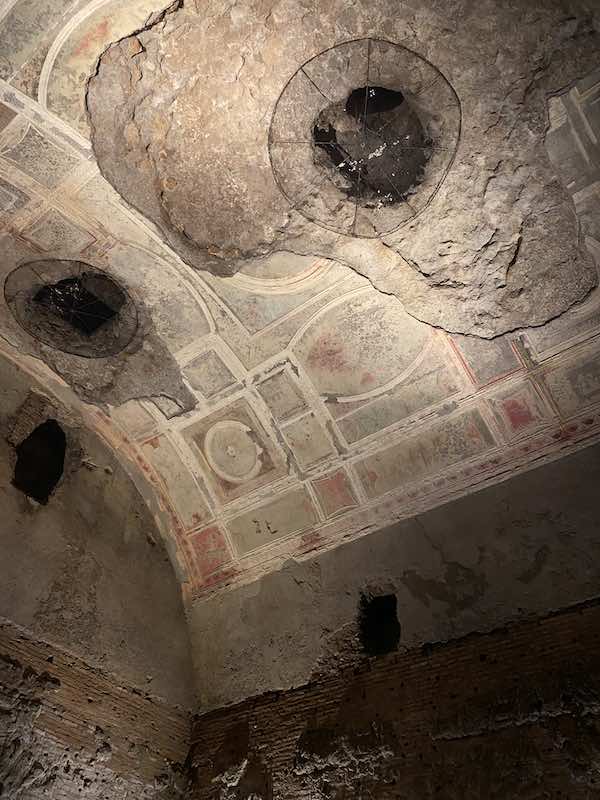
All precious materials and most of the sculptures in the Domus Aurea got stolen however, it was possible to salvage the Laocoon, one of the most important statues in Rome, now preserved in the Vatican Museums.
The Domus Aurea is a very delicate and endangered environment.
In fascist times, the land above it was turned into a garden with monumental trees and their roots plus the weight of the soil cause infiltrations and pressure on the Domus walls.
Now, there is a project to turn the garden into a much lighter one to preserve this incredible building and avoid ruinous collapsing of its part – some of it fell on itself years ago and cause terrible damage as well as forcing the closure of the Domus.
The Domus Aurea and the Grottesche
The word ‘grottesche’ describes a specificities style of figurative art that became popular in the late 1400s -1500s.
The history of ‘grottesche’ starts around 1480.
At that time, it was known that beautiful frescos were hidden in underground ‘grottoes’ in the Oppian Hill and artists such as Pinturicchio, Lippi and Signorelli, used roped and torched to study and admire them.
They were aware to be in front of Roman art however, they believed them to be part of the baths of Titus, rather than part of the more ancient Domus Aurea.
Later, Raphael took an interest in these paintings and great inspiration from them.
At his time, they were still referred as ‘grotesque’ (of the grottoes). The name still applies to this style even now that we know these spaced were all but grottoes!

Experts can see the style of grottesche in Raphael’s work in the décor of Cardinal Bibbiena’s apartment in the Vatican, and in the Loggetta, which was almost a last rehearsal before the creations of Raphael’s most famous frescoes in the Vatican (Stanze di Raffaello).
The influence of the grottesche went well beyond its time and that of Raphael: Klee, Dali, Miro’ and surrealists, in particular, were highly influenced by them, which they interpreted in both aesthetic and symbolic terms.
Visiting the Domus aura with kids
The Domus Aurea is child friendly and I believe is one of the most impressive archaeological sites to visit in Rome with kids of school age.
Due to the nature of the place, I find it would have little relevance and interest to children with no grasp of Roman history but children of primary school age and up can enjoy it.

At physical level, they will find interesting to be underground (it is also much cooler than outside, a fact that is noticeable in itself!), they will enjoy the video and they will also find the stories entertaining.
However, the house is not a place with much to do as such nor one you can visit in your own time so you need children who are happy and able to keep their attention up for the tour duration.
I visited with my two children and they enjoyed taking photos of the place and also recognize some stories that they had heard on horrible histories – I highly recommend you have a book about ancient Rome and Nero in particular before your visit to make the most of the day.
The Domus is stroller-friendly.
Top tip: in the Domus, you can take photos only without a flash. Make sure you can turn off the flash on your kids’ camera or give them your phone (or a spare one) and set the right setting yourself.
The things my kids enjoyed the most in the Domus Aurea are:
- The initial video
- The ceiling holes and the story of the thieves
- The stories of the lavishly decorated house
- The frescoes, especially the most colorful ones
- The room that used to open onto the main patio: now the patio if full of debris and gives a scale of the work the archaeologist did to bring the palace back from the earth!
What to bring to visit the Domus Aurea
You don’t need special gear to visit the Domus Aurea however, you should make sure you carry with you:
- Face mask
- Green pass (from 6th August 2021)
- Comfortable walking shoes or sandals – you can find here >>> recommended shoes for Rome.
- A sweater / jumper even in summer: the Domus is significantly colder than outside and you will need an extra layer during the visit. In the height of summer, a light sweater is enough. Ensure you have a cover / blanket for kids in the stroller as they are likely to feel cold there.
What to see near the Domus Aurea
The Colosseum – just in front of the Domus Aurea, it can be visited on the same day
The Roman Forum and Palatine Hill – also in front of the Domus Aurea, it can be visited on the same day (please note: visiting the Domus Aurea, the Colosseum and the Forum is technically possible in one day but it is too much and I advise against it)
The Caelian Hill, the wonderful home of Santo Stefano Rotondo and San Clemente Churches, as well as the fabulous Santi Quattro Coronati
The Monti Neighborhood, a lovely local area with historical and hipster charm (includes Santa Prassede and Santa Pudenziana, two of the best places to see mosaics in Rome) and Santa Maria Maggiore.
Il Vittoriano, the interesting altar to the fatherland in Piazza Venenzia
I hope you enjoyed this quick guide to the Domus Aurea and it helped you plan your visit. Safe travel planning!
